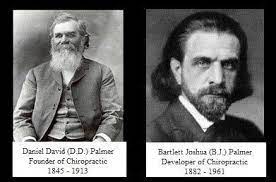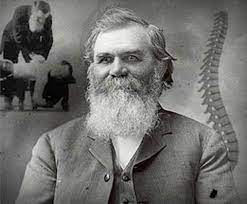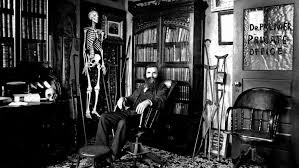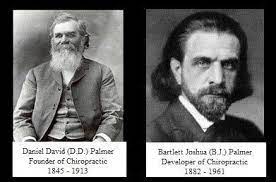Who Invented Chiropractic? – Daniel David Palmer –
The history of chiropractic care can be traced back to the late 19th century when it was first introduced by Daniel David Palmer. Palmer, often referred to as the “Father of Chiropractic” developed a keen interest in alternative healing methods and sought to understand the relationship between spinal health and overall well-being. It was his groundbreaking discovery that led to the birth of chiropractic as we know it today.
The field of chiropractic care has a rich and fascinating history that dates back over a century. Originating from humble beginnings, chiropractic has evolved into a widely recognized and respected form of alternative medicine. In this section, we will delve into the origins and evolution of chiropractic, exploring its inception, key milestones, and the individuals who played pivotal roles in shaping this unique healthcare discipline.

The field of chiropractic care has a rich and fascinating history that dates back over a century. Originating from humble beginnings, chiropractic has evolved into a widely recognized and respected form of alternative medicine. In this section, we will delve into the origins and evolution of chiropractic, exploring its inception, key milestones, and the individuals who played pivotal roles in shaping this unique healthcare discipline.
As we explore the history of chiropractic, we will uncover how Palmer’s invention sparked controversy within the medical community at that time. The establishment viewed chiropractic as an unconventional practice and questioned its legitimacy. However, despite facing opposition, Palmer’s vision persisted and gained traction among those seeking natural approaches to healthcare.
Over time, chiropractors refined their techniques and expanded their knowledge base through scientific research and clinical experience. This evolution led to advancements in spinal manipulation techniques, diagnostic tools, and an increased understanding of the body’s intricate musculoskeletal system.
Who Developed Chiropractic? – B.J. Palmer –
In addition to examining key milestones in chiropractic’s journey, we will also highlight influential figures who have contributed significantly to its development. From early pioneers like B.J. Palmer – Daniel David Palmer’s son – who furthered his father’s work through research and education initiatives; to modern-day practitioners who continue to push boundaries with innovative treatments and evidence-based practices.
Join us on this captivating exploration as we seek to answer the question, “Who Invented Chiropractic?” and unravel the origins and evolution of chiropractic care – a testament to human curiosity, resilience, and our ongoing quest for holistic well-being through natural means.
The Pioneers: Exploring the Key Figures in the Development of Chiropractic

The development of chiropractic as a holistic healthcare practice owes much to the visionary individuals who pioneered its principles and techniques. In this section, we will explore the key figures who played instrumental roles in shaping chiropractic into what it is today.
One of the most significant figures in chiropractic history is Daniel David Palmer, often referred to as the founder of chiropractic. It was in 1895 that Palmer performed his first spinal adjustment on a deaf janitor, leading to a remarkable restoration of his hearing. This breakthrough moment marked the birth of chiropractic and set Palmer on a path to further explore and refine his techniques.
Another crucial figure in advancing chiropractic was BJ Palmer, son of Daniel David Palmer. BJ Palmer dedicated his life to expanding upon his father’s work and taking chiropractic to new heights. He played an instrumental role in developing specific techniques such as the “Palmer Toggle Recoil” method, which focused on precise spinal adjustments for optimal results. Through his leadership and relentless pursuit of excellence, BJ Palmer solidified chiropractic’s place as a respected healthcare discipline.
While Daniel David and BJ Palmer are undoubtedly central figures in chiropractic history, it is important to acknowledge other prominent contributors who have made notable contributions along the way. These individuals have brought their unique perspectives and expertise to further enrich the field of chiropractic.
In this section, we will delve into their stories, exploring their significant contributions that have shaped modern-day chiropractic practices. By understanding the pioneering efforts of these key figures, we can gain a deeper appreciation for how far this discipline has come and appreciate their lasting impact on our health and well-being.
The Evolution and Recognition of Chiropractic as a Legitimate Healthcare Profession
Initially, chiropractic faced skepticism and skepticism from traditional medical practitioners. However, with advancements in research and growing evidence of its effectiveness, chiropractors have successfully proven their worth as valuable contributors to the healthcare field.
Over the years, chiropractic has evolved from being viewed as an alternative therapy to gaining recognition as a legitimate healthcare profession. The journey of chiropractors towards establishing their credibility and gaining acceptance in the medical community has been remarkable.
One key factor in the recognition of chiropractic as a legitimate healthcare profession is the rigorous education and training that chiropractors undergo. Chiropractic programs now require extensive coursework in anatomy, physiology, neurology, and other relevant subjects. This ensures that chiropractors possess a solid foundation of knowledge and skills necessary for providing safe and effective care.
Furthermore, professional organizations such as the American Chiropractic Association (ACA) have played a crucial role in advocating for the legitimacy of chiropractors. These organizations work tirelessly to promote research, education, and public awareness about the benefits of chiropractic care.
The growing acceptance of chiropractic by insurance companies is another indicator of its legitimacy. Many insurance providers now cover chiropractic services due to their proven effectiveness in treating various musculoskeletal conditions.
Moreover, patients themselves have recognized the value of chiropractic care. With increasing numbers seeking non-invasive treatment options and a focus on holistic well-being, more individuals are turning to chiropractors for relief from pain and improved overall health.
In conclusion, through extensive education, advocacy efforts by professional organizations like ACA, acceptance by insurance providers, and positive patient experiences; the legitimacy of chiropractic as a healthcare profession has been firmly established. Chiropractors are now recognized as integral members of multidisciplinary healthcare teams who play a vital role in improving patient outcomes and promoting overall wellness.
The Influence and Impact of Chiropractic on Modern Healthcare Practices
Chiropractic care has made a significant impact on modern healthcare practices, revolutionizing the way we approach and treat various health conditions. The integration of chiropractic techniques into mainstream medicine has paved the way for a more holistic and patient-centered approach to healthcare.
The influence of chiropractic on healthcare practices is evident in its ability to provide non-invasive and drug-free solutions for numerous musculoskeletal issues. By focusing on the spine and nervous system, chiropractors aim to restore proper alignment, alleviate pain, and enhance overall well-being.
In recent years, doctors of chiropractic have become increasingly recognized as an essential component of comprehensive healthcare systems. Many medical professionals now acknowledge the benefits of collaborating with chiropractors to offer patients a more integrative approach to treatment.
The impact of chiropractic in modern medicine extends beyond just physical health. Chiropractors also emphasize the importance of lifestyle modifications, exercise, and nutrition in achieving optimal wellness. This holistic perspective aligns with the growing trend towards preventive care and personalized medicine.
As more research emerges supporting the effectiveness of chiropractic care, its integration into mainstream healthcare systems continues to gain momentum. The collaboration between medical doctors and chiropractors allows for a more comprehensive understanding of patient needs and ensures that individuals receive the most appropriate care for their specific condition.
In conclusion, chiropractic’s influence on modern healthcare practices cannot be understated. Its integration into mainstream medicine has provided patients with alternative treatment options that prioritize overall well-being. As we move forward, it is clear that chiropractors will continue to play a vital role in shaping the future of healthcare by promoting holistic approaches that address both physical and mental health concerns.
Misconceptions and Controversies Surrounding the Invention and Practice of Chiropractic
Controversies surrounding chiropractic have also emerged due to differing opinions on its effectiveness and safety. Some critics argue that certain techniques used in chiropractic adjustments may pose risks or lack scientific evidence. However, it is crucial to note that extensive research has been conducted to evaluate the benefits and potential risks associated with chiropractic care.
In the field of chiropractic, there have been numerous misconceptions and controversies surrounding its invention and practice. These misperceptions often arise from a lack of understanding or misinformation about the history and principles of chiropractic care.
One common misconception is that chiropractic was invented by a single individual. In reality, chiropractic evolved through the contributions of various pioneers in the field. While Daniel David Palmer is often credited as the founder of modern chiropractic, it is important to acknowledge that he built upon the work of others before him.
It is important to approach these misconceptions and controversies with an open mind and seek reliable information from reputable sources. By gaining a comprehensive understanding of the history, principles, and current practices within chiropractic, we can foster informed discussions and make well-informed decisions about this alternative healthcare approach.
Conclusion: Appreciating the Legacy and Contributions from those who Invented Chiropractic

In conclusion, it is crucial to appreciate the legacy and contributions of the pioneers who invented chiropractic. Their groundbreaking work has revolutionized healthcare and brought about significant advancements in spinal health and well-being.
The invention of chiropractic has provided millions of people with a non-invasive and drug-free approach to healing. The pioneers behind this practice dedicated their lives to understanding the intricate relationship between the spine, nervous system, and overall health.
Their contributions have not only led to effective treatments for various musculoskeletal conditions but have also paved the way for further research and development in this field. Chiropractic care has become an integral part of holistic healthcare, offering individuals a natural alternative to traditional medical interventions.
We owe a debt of gratitude to these pioneers for their unwavering commitment and determination in establishing chiropractic as a legitimate healthcare profession. Their innovative techniques and philosophies continue to shape the industry, providing hope and relief to countless individuals seeking pain management and improved well-being.
As we reflect on their legacy, let us remember that their inventions have had far-reaching effects beyond just physical health. The principles they established have inspired generations of chiropractors who continue to carry forward their vision, ensuring that future generations can benefit from this remarkable form of treatment.
In conclusion, we must appreciate the legacy left by these pioneers in chiropractic. Their contributions have transformed lives, challenged conventional medical practices, and paved the way for a more holistic approach to healthcare. Let us honor their memory by recognizing their invaluable impact on our well-being and appreciating the ongoing advancements made possible through their inventions.
To learn more about chirporactic care contact our Bozeman or Belgrade offices and schedule an appointment today.

